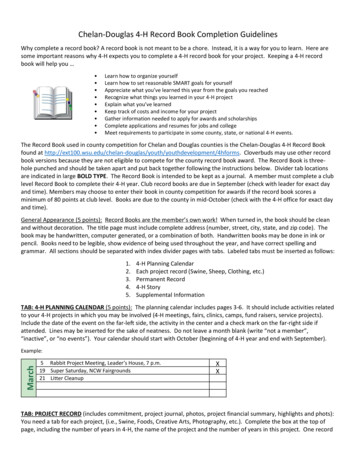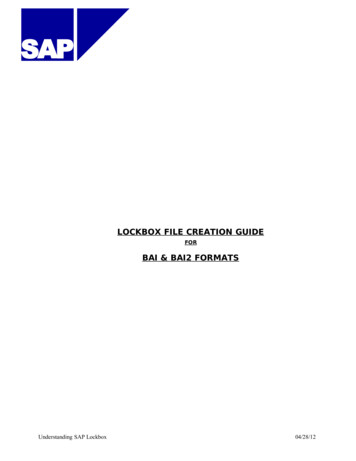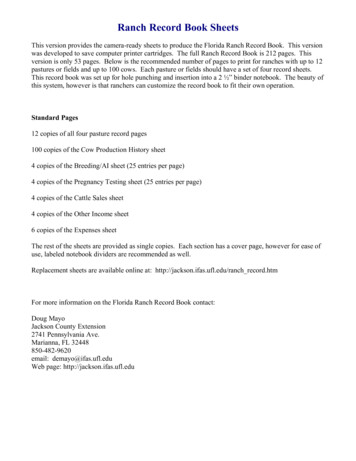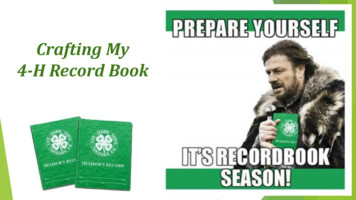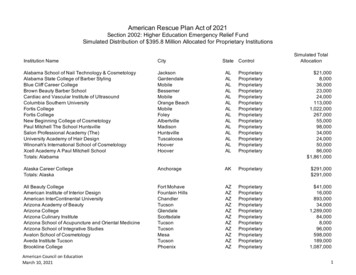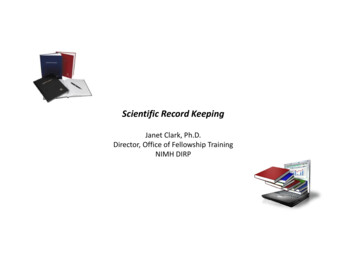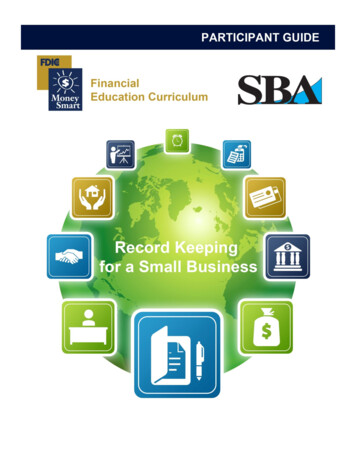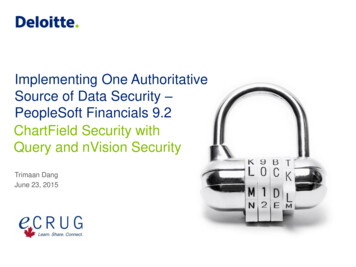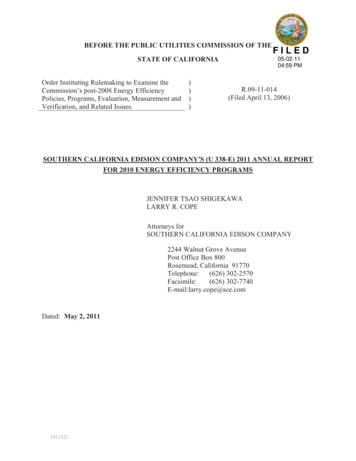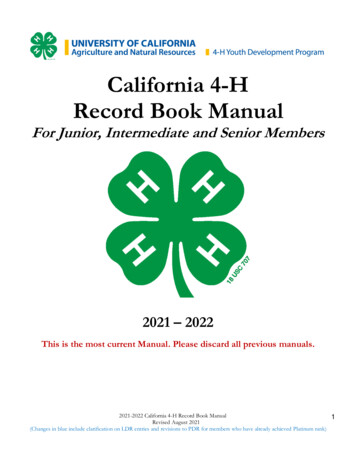
Transcription
California 4-HRecord Book ManualFor Junior, Intermediate and Senior Members2021 – 2022This is the most current Manual. Please discard all previous manuals.2021-2022 California 4-H Record Book ManualRevised August 2021(Changes in blue include clarification on LDR entries and revisions to PDR for members who have already achieved Platinum rank)1
Table of ContentsPurpose of Record Books . 3Positive Youth Development Terms . 3General Information . 4Formatting Instructions . 6Organization Overview . 8Section 1: Preliminary Information. 9Section 2: Personal Development Report (PDR) . 10Section 3: My 4-H Story . 18Section 4: Annual Project Report (APR). 19Section 5: Collection of 4-H Work . 21Section 6: Leadership Development Report (LDR). 22Section 7: 4-H Resume . 25Evaluation and Competition . 26Submitting Your Book to State Competition . 27Looking for forms? Forms can now be found on the State 4-H Website:http://4h.ucanr.edu/Resources/Member Resources/RecordBook/You can also make a copy of the forms in Google Sheets or Google docs. Be sure to use a personal gmail address—NOT your school gmail. Schools block outside copying of documents, so if you request access permission, it will bedenied. Set up your own personal, free gmail account. Get help and permission from your parent or guardian beforedoing this.Google Docs LinkGoogle Sheets LinkCopyright 2021 The Regents of the University of California.2021-2022 California 4-H Record Book ManualRevised August 2021(Changes in blue include clarification on LDR entries and revisions to PDR for members who have already achieved Platinum rank)2
Purpose of Record BooksHistoryThe California 4-H Youth Development Program (YDP) has a long history ofrecord-keeping as an activity by 4-H members. To move youth on a path towardthriving within their communities, the 4-H Record Book goes through periodicchanges to meet the needs of youth and mission of 4-H YDP.The Purpose of the 4-H Record Book:Reflect on your yearly work by documenting your skill development,learning experiences and growth in 4-H.Set goals, pursue strategies to meet those goals and shift gears in the faceof challenges and obstacles.Be awarded for your involvement in 4-H activities. Earn Star Ranks.Build competency through creating and preserving your records.Help you grow through continued exposure to positive experiences that support your development ofthe 6 Cs: competence, confidence, character, caring, connection and contribution.Positive Youth Development TermsThe California 4-H Record Book incorporates thriving language. Thriving is also called reaching your fullpotential—and that’s what 4-H is all about—helping you be the best you!Here are some of the words and terms you will see that you may want to know more about while completing yourRecord Book: Sparks are passions and skills that are meaningful and motivating to you. If you do or are something in 4-Hor your life that brings you great joy AND you use that thing to make a positive difference in the world—then that’s your Spark!Growth mindset. The effort that you put into completing the Record Book helps strengthen theconnections in your brain. A growth mindset includes viewing challenges as opportunities to learn even if itmeans changing or not reaching a goal or strategy.GPS goal management skills. Throughout the 4-H Record Book, you set Goals, Pursue strategies to reachthose goals and Shift gears in the face of challenges or obstacles.The 6 Cs: competence, confidence, character, caring, connection and contribution; all of them areimportant on your path to thriving.Adult Volunteers are adults or staff members who have been appointed as leaders of a particular activity orgroup. They can be project leaders, community club leaders, advisors, coaches, mentors, etc. When a formasks for an adult volunteer signature, it means an appointed 4-H adult who may or may not be a parent orguardian.2021-2022 California 4-H Record Book ManualRevised August 2021(Changes in blue include clarification on LDR entries and revisions to PDR for members who have already achieved Platinum rank)3
General InformationYour Record Book is YOURS 4-H Record Books must be completed by the 4-H member – that means you! This includes completing forms,writing the 4-H Story and other records. Adults may assist by guiding, explaining and helping to compileinformation and proofreading. It’s important that you record what YOU learned and not copy the work of others. And it Goes Where You Go!Personal Development Report participation and star ranks transfer from one California county to other counties.Former participation in other states can be counted in the California 4-H Record Book PDR form as long as youwrite it down.Record Books are OPTIONAL!Record Books cannot be required for participation in 4-H activities and events. They also cannot be required foryou to be elected as an officer or other leadership roles. A 4-H Record Book or parts may be required to receiveparticipation awards (such as star ranks, medals or pins) that are based on Record Book achievements. Somemembers only complete the Personal Development Report to keep track of their Star Ranks.Autographs, please!You’ll need to get signatures on some forms from an adult volunteer after they review the 4-H work you havedocumented in your Record Book. Review, discussion and signatures are required on the following forms:Where?Who Signs?First page of Personal Development ReportYouth Member and Adult VolunteerLast page of each Annual Project ReportYouth Member and Project LeaderPart 1 (Post) ofYouth MemberLeadership Development ReportPart 2 (Pre) and Part 2 (Post) ofYouth Member and Adult VolunteerLeadership Development ReportAutographs on Google Sheets or Google DocsRecord book forms are available in both Google Sheets and Google Docs now. (See pg 2 for links). To get therequired signatures, please plan to share your Google Doc or Google Sheet with a 4-H adult volunteer who canverify your work. To do this, the adult volunteer will need to tell you their email address so you can add them toyour document or sheet.Hours of Participation You will be asked to record the number of hours spent in 4-H meetings, activities, events,planning/organizing and other 4-H activities in the PDR and the APR forms. Record times as decimals orwhole numbers. See the time conversion chart below to help change minutes to decimal hours. Do not count hours you are not spending in a 4-H activity. For example, do not count hours while you areasleep at 4-H camp.2021-2022 California 4-H Record Book ManualRevised August 2021(Changes in blue include clarification on LDR entries and revisions to PDR for members who have already achieved Platinum rank)4
Special AccommodationsThe core values of the California 4-H Youth Development Program state that we “appreciate, respect and valuediversity through a commitment to inclusion of diverse Californians.” If you cannot complete your Record Book inthe standard format, 4-H is more than happy to accommodate you. Accommodations are made on a case-by-casebasis. Speak with your UCCE County Community Education Specialist to make a request.Questions?If you have questions while completing your Record Book, ask an adult volunteer in your club or county to helpyou. This Record Book Manual is designed for members, adult volunteers and staff.2021-2022 California 4-H Record Book ManualRevised August 2021(Changes in blue include clarification on LDR entries and revisions to PDR for members who have already achieved Platinum rank)5
Formatting InstructionsIf you plan to submit your Record Book to any competition, you must follow these guidelines to receive themaximum points for this section. We highly recommend that you use a computer to complete your Record Book forms. However,handwritten forms are acceptable.Google versions of the Record Book are encouraged. If you are using an electronic version of your RecordBook, especially Google Sheets, the instructions below for printed materials may be adjusted if you need toprint your book for evaluation or competition. Check with your club and county to see if you can submityour book electronically so no printing is required.All books submitted to State Competition will be electronic. The required Cover Sheet and County CheckSheet will be submitted electronically.For Printed Books: Paper:o 8 ½ inch x 11 inch plain white copier paper for most sections. The Title Page may be any color orspecial paper and still must be 8 ½ inch x 11 inch.o Double-sided is okay.o Photo quality paper is okay only on pages with photographs in the Collection of Work and/orExpression Pages.Margins:o Pages may be printed in portrait or landscape. Use the setting that makes it read easily.o If printing out Word or Google docs forms and placing your Record Book in the Record Book Coveror in a Binder: Left margin between 1 inch and 1½ inch. All other margins (top, bottom, and right)should be between ½ inch and 1 inch.o If sharing the url to your digital Google forms, use ½ inch to 1-inch margins all around.o If printing out a Google Sheet, set margins to not less than ½ inch all around.o If used, headers, footers are preferrably inside these margins.o Page numbers can be outside the margins.Typeface:o Typed or handwritten in black or blue ink.o Color may be used on the Title Page, Table of Contents, Expression Pages and the Collection ofWork.o If handwritten, text must be written legibly. If typed, no less than 11 point in an easy to read font.Font size may differ for headings and emphasis in text.Divide and Label Sections:o Use tabs and divider pages to separate sections and improve overall organization. Colored paper maybe used as section dividers.Graphics:o Graphics, pictures and drawings may only be included on the Title Page, Table of Contents,Expression Pages and the Collection of Work.2021-2022 California 4-H Record Book ManualRevised August 2021(Changes in blue include clarification on LDR entries and revisions to PDR for members who have already achieved Platinum rank)6
Number the Pages:o Use a logical system that matches your Table of Contents to number the pages of your Record Book.Hand numbering is acceptable due to the significant number of inserted pages. Numbering usingprinted stickers is okay. Folder or Binder:o Use an Acco fastener folder or 3-ring binder, not more than 1” wide. Acco Record Book Covers maybe purchased from the Shop 4-H. Other:o Do not exceed the page limits for each section.o Do not use plastic page covers or laminate any pages.PAGE GUIDELINES for Printed Forms2021-2022 California 4-H Record Book ManualRevised August 2021(Changes in blue include clarification on LDR entries and revisions to PDR for members who have already achieved Platinum rank)7
Organization OverviewA California 4-H Record Book contains the following items.Section 1: Preliminary Information Title PageTable of ContentsSection 2: Personal Development Record Complete one Personal Development Report (PDR) form each year.Already have a Platinum Star? New short version PDR is acceptable. See PDR section for more details.Section 3: My 4-H StorySection 4: Projects* One Annual Project Report (APR) form for every project you have completed.One expression page for every project.Section 5: Collection of 4-H WorkSection 6: Leadership Development Report (Intermediate and Senior Members Only) Complete one Leadership Development Report (LDR) Part 1(Pre) and Part 1(Post) per year.Complete one Leadership Development Report (LDR) Part 2(Pre) and 2(Post) per leadership role, peryear.Section 7: 4-H Resume (Senior Members Only) Senior members create a 4-H Resume that highlights their skills, leadership and civic engagementdevelopment throughout their 4-H career.A Note about previous year’s records:All of your previous years records can be inserted at the back of the current year’s book, in reverse chronologicalorder (that means by year and the year you started is in the back and you work forward to the current year in thefront) or you can have a separate book for each year—the option is up to you. Some county competitions want tosee all of your previous records—so be sure to find out what your county wants before you compete.Sending to State Competition? Only submit the current year’s records—don’t send any previous year’srecords. The last section will be Section 7: 4-H Resume, there shouldn’t be anything behind that.Are you a Junior, Intermediate, or Senior Member?Ages 9 through 10Junior MemberAges 11 through 13 Intermediate MemberAges 14 through 19 Senior Member*You must complete at least one Annual Project Report (APR) form to receive a year stripe and pin.2021-2022 California 4-H Record Book ManualRevised August 2021(Changes in blue include clarification on LDR entries and revisions to PDR for members who have already achieved Platinum rank)8
Section 1: Preliminary InformationTitle PageA title page includes your full name, 4-H Club, your county and the program year. The title page may be a colorother than white paper, use graphics, photos and larger text. The title page must not exceed one standard page.Table of ContentsA table of contents lists the order of the 4-H Record Book sections. Include the titles of the section headers andpage numbers. A 4-H Record Book is organized into the following sections.Section 1: Preliminary Information . .page numbersSection 2: Personal Development Report . page numbersSection 3: My 4-H Story . page numbersSection 4: Annual Projects. . . page numbers(This section includes Annual Project Reports and Expression Pages. Each project may have itsown subsection or all of the projects may be contained within one section)Section 5: Collection of 4-H Work . . page numbersSection 6: Leadership Development Reports(s) . page numbers(Intermediate and Senior Members Only)Section 7: 4-H Resume . . page numbers(Senior Members Only)“Strive for excellence, not perfection.” H. Jackson Brown Jr.2021-2022 California 4-H Record Book ManualRevised August 2021(Changes in blue include clarification on LDR entries and revisions to PDR for members who have already achieved Platinum rank)9
Section 2: Personal Development Report (PDR) Record participation and activities both inside and outside of 4-H for the current program year.When you attend a 4-H event, both virtually and in-person, record it as a 4-H Event Attended.If you did something at that event that meets the requirements in another area(s), you can record that aswell, BUT that activity can only be counted in one category—it’s your choice.Record activities in the most appropriate or needed category for Star Ranks.Example: State Field Day—Event Attended At Field Day you gave a presentation on how to create a service-learning project. You could count thispresentation as a Communication Skill. If you won a gold seal/medal for your presentation, you would listthat award in Honors and Recognition.Platinum Star Awardees: If you already have your Platinum Star, you can skip sections of the PDR beginning the year after you earnyour Platinum Star. Everyone completes sections 4 and 5. Platinum Star awardees have the option to skip sections 1-3 and 6-8. While not required, you may want tocapture one of more of these optional sections. If you plan to apply for scholarships or college, you mayfind some of the information very helpful.Additional Space You may add pages, rows or lines to each category as needed. Do not delete columns of required information. All columns are required.Level of participation In categories 2 through 8, identify your level of participation in each activity. The levels are:I Individual, L Local Club/Unit/Project, C County,M Multi-county, S State, N National/Multi-State, G GlobalStar Ranks Star ranks are designed to encourage you to participate in a wide variety of activities and to provide you withan opportunity to set (and reach!) your goals. Each category lists the Star Rank requirement. On the first page of the PDR, the second box asks you to list your club meeting attendance for the year. Ifyou are in a SPIN club, your club meeting/project meeting are the same in most cases– so your clubmeeting attendance (on the first page) and project meeting attendance (on the third page) will be the same.Activities Inside and Outside of 4-H You may record up to two significant activities outside of 4-H in categories 2, 4, 5, 6 and 7. Category 8 may ONLY include activities outside of 4-H. All activities must meet the instructions and guidelines for each category.2021-2022 California 4-H Record Book Manual10Revised August 2021(Changes in blue include clarification on LDR entries and revisions to PDR for members who have already achieved Platinum rank)
Activities from the Previous Year If you forgot to record an activity or event from a previous program year, you may record it on the currentyear’s PDR. This is an exception, and not intended to allow a member to go back and add a full year’s worthof activity. If you didn’t do a book last year, that’s okay, start from where you are this year. You must have proof of participation and the approval of an adult volunteer. Record the information as you would for activities and events of the current year (date, activity, location,and level).2021-2022 California 4-H Record Book Manual11Revised August 2021(Changes in blue include clarification on LDR entries and revisions to PDR for members who have already achieved Platinum rank)
Personal Development Record (PDR) Categories1. Projects Completed (optional for Platinum Star holders)Record the projects you have completed. Complete a minimum of six hours of project instruction or more as required by the project leader.Instruction can be virtual or in-person. If you are participating in a training related to your projectand you want to count it toward your project completion, get permission from your project leaderfirst. During the current year, 80% average attendance across all projects is required to receive anachievement rank.2. Project Skill Activities (optional for Platinum Star holders)Record events or activities that demonstrate your knowledge to an audience or judge. Activities may berecorded even if you are not enrolled in the corresponding project – as long as the skills are related to a 4-Hproject. Exhibits: Record exhibition entries such as animals, foods, crafts or other items. You may receivemultiple credits for the same exhibit presented before a new audience at a different event.o Judged Exhibits: Each entry or collection of entries related to one project counts as onecredit. For livestock, each species and project shown counts as one credit.All foods entries count as one credit, all photography entries count as one credit, allmarket chicken entries and all show chicken entries each count as one credit.Examples: Fair entries, Fashion Revue, State Photography Competition, educationaldisplays (if judged).o Non-Judged Exhibits: Each show or event counts as one credit regardless of the numberof items exhibited.Examples: Parents’ Night, National 4-H Week exhibit, public building display. Showmanship: Record each time you compete in a showmanship competition as a 4-H member.Each individual showmanship competition may be counted separately. Knowledge Contests: Record participation in 4-H knowledge bowls, contests or other activitiesthat test your knowledge.o Examples: Horse bowl, Avian bowl, Horticulture Contest, Champion Challenge. Judging Contest: Record participation in any organized 4-H judging contest where you are judgedby a set of standards on how well you judged.o Examples: Livestock Judging Day, Field Day Judging Contests. Project Skill Activities Outside 4-H: Record participation at shows, competitions and conteststhat relate to a 4-H project skill but are NOT strictly 4-H events or do not have 4-H classes.o Examples: Pacific Poultry Breeders Association Show, ARBA National Convention, AKCDog Show, Quilting Conference (QuiltCon).You may not participate as a 4-H member or record activities in jackpot or prospector shows thatdo not comply with 4-H Policy. Events that do not comply with 4-H Policy may not be recorded inthe Record Book at all.2021-2022 California 4-H Record Book Manual12Revised August 2021(Changes in blue include clarification on LDR entries and revisions to PDR for members who have already achieved Platinum rank)
3. Events Attended (optional for Platinum Star holders)Record 4-H virtual and in-person events that you attend during the year. Count any 4-H event that youattend outside of regular club and project meetings. Be sure to get permission from your club or projectleader(s) for virtual events that you attend that could count for 4-H learning. Multiple day events, such asCounty Fair and Conferences count as one event.o Examples:California FocusFashion RevueClub Holiday DinnerField DaysAchievement NightOfficer TrainingFundraisersLivestock ClinicsEquine Play DaysLeadership ConferenceYou may receive credit for attending the event as well as completing an activity that fits in anothercategory.o Example: Attending County 4-H Presentation Day is counted in category 3 (EventsAttended) and presenting a demonstration is counted in category 6 (Communication Skills).A Note about Fairs:If the fair you attend has a 4-H/FFA class, you can enter it as a 4-H Event Attended, even if the fair is notoperated by 4-H. Shows and contests that are neither operated by 4-H nor consisting of 4-H showingdivisions/classes are NOT considered 4-H events. If the show or contest relates to a 4-H project skill, itmay be included in category 2 as a “Project Skill Activity Outside 4-H.”4. Leadership Development (all members complete this section)Record each project that you lead and each leadership position you hold at the club, county, sectional, stateand/or national levels. The duties you perform in leadership roles are considered part of the position andcannot be counted as separate activities for any category on the PDR—for example, if you have to give areport as a Club Officer, you cannot count your report as a Communication Skill because this reporting ispart of your job as an officer. Committee Chair or Member: Record the committee where you served.o Examples: Club phone tree, Field Day Set up committee, 4-H Parents’ Night Decorationscommittee, County Presentation Day Judges Refreshment committee. Junior Leader: If you are younger than 11 and not yet an intermediate member, count your projectleadership in the PDR. Lead a 4-H Group Activity: An activity can be planned ahead or it can be spontaneous*, usuallyon a one-time basis, to benefit 4-H members, volunteers or the community. As long as you took thelead to make it happen, you can count it. *Spontaneous means that you didn’t prepare anything, butyou responded to lead, in the moment that something happened, that required knowledge andleadership skills to solve the situation. Leadership Outside of 4-H: You may count two of your most significant leadership roles outsideof 4-H and record them in this category.o Examples: Student Body President, School Math Tutor, Youth Group LeaderSignificant 4-H Leadership Roles for Intermediate and Senior MembersTo meet the Star Rank criteria for gold and platinum stars, you must hold significant 4-H leadership rolesthat require 20 hours or more of leadership contribution. Count all of your training, meeting, planning and2021-2022 California 4-H Record Book Manual13Revised August 2021(Changes in blue include clarification on LDR entries and revisions to PDR for members who have already achieved Platinum rank)
research hours as well as the hours spent leading toward this requirement. You must complete theLeadership Development Report form to receive credit for these roles.See next page for examples of Significant Leadership Roles.Examples of Significant 4-H Leadership Roles for Intermediate and Senior Members:Enrolled in a 4-H Leadership Development Project, County Ambassador, Junior or Teen Leader, ClubOfficer, Camp Counselor, Exchange Program, State Ambassador, Youth Board Member, Youth Key LeaderJunior members may earn Significant Leadership credits if these conditions are met:1. You are a Club Officer2. You already have earned a Silver or Gold Star and you are working on either Gold orPlatinum Star3. You and your adult volunteer believe you understand all of the questions in the LDR andyou believe that you can learn something by completing them.5. Civic Engagement and Community Service (all members complete this section)Record your active participation in a planned, publicized and approved civic engagement, service learning orcommunity service activity. Credits are counted by event attended, not separate activities at that event.If an event or activity is recurring, separately count your participation in each one.o Example: Record each monthly visit to a convalescent home.Do not count fundraising activities for personal benefit under Civic Engagement/Community Service. Thisincludes fundraising activities that support group attendance at county, sectional, state or national 4-Hevents. You may record this activity under category 3 (Events Attended). Community Service Project: Record events and activities that serve the common good in theinterest of the community or members of the community.o Examples: Canned food drive, beach cleanup, clothes drive, convalescent home visit. Service Learning Project: Service learning combines service and education to address a recognizedneed in the community. It involves collaboration with others and includes a time for reflection onthe experience. See the state 4-H website for more information on how to conduct service learningevents. You can receive two (2) credits for Service Learning Projects. Make one entry forService Learning Project Learning and Planning and one entry for the Service Learning ProjectEvent—that’s when you actually do what you planned.o Examples: Learning about water issues and painting storm drain signs; learning aboutpersons with disabilities and designing a help aid to meet an identified need. Civic Engagement and Civic Affairs: Record events and activities in which you are engaging inone or both of the following categories as a part of your 4-H experiences:o Civic EngagementAdvocacy, activism and discussion on civic issues with informed decision making.o Civic EducationGovernment principles, processes and structures; personal roles and responsibilities;history and cultural heritage; global understanding2021-2022 California 4-H Record Book Manual14Revised August 2021(Changes in blue include clarification on LDR entries and revisions to PDR for members who have already achieved Platinum rank)
o Examples: attending Citizenship Washington Focus or California Focus, volunteering at avoter registration, completing a Safe Space training. Civic Engagement and Community Service Outside of 4-H: Count two significant civicengagement or community service roles and record them here.o Examples: School clothing drive for disaster victims, donating at a blood drive.6. Communication Skills (optional for Platinum Star awardees)Record communication activities that you participate in at any event inside or outside 4-H. Do not includethank you letters as communication activities. 4-H Presentations: To be counted as a presentation, you must meet the requirements in the State4-H Presentation Manual. Any time you speak to a new audience at a new event, record it (repeatingat the same event or practicing your presentation does not count). Prepared Talk: Any time you prepare (in advance of the event or activity) a report or talk, recordthis here. Officer reports or committee reports are considered part of your role and are not counted. Radio and Television Appearances: When you appear as a guest representing 4-H before a radioor television audience, record it here. You must be actively involved in the interview orpresentation. Newspaper Articles: Record the number of articles that you write and submit to local/schoolpapers, 4-H newsletters and 4-H websites. If the article was not published, you may receive credit ifit is submitted and approved by your adult volunteer. This does not include articles that arewritten about you—regardless of who the author is. Letters: Record letters that you crafted to teach others about 4-H and/or persuade communitymembers to participate in a 4-H event. If you wrote one letter and sent it to multiple recipients, itstill counts as one credit. Do not include thank you letters.o Example
Personal Development Report participation and star ranks transfer from one California county to other counties. Former participation in other states can be counted in the California 4-H Record Book PDR form as long as you write it down. Record Books are OPTIONAL! Record Books cannot be
